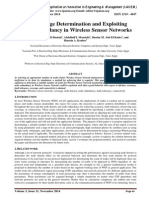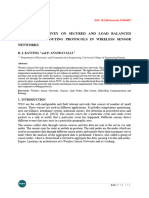An Energy Efficient Algorithm To Avoid Hot Spot Effects in Wireless Sensor Networks
An Energy Efficient Algorithm To Avoid Hot Spot Effects in Wireless Sensor Networks
Uploaded by
Sugumar Sar DuraiCopyright:
Available Formats
An Energy Efficient Algorithm To Avoid Hot Spot Effects in Wireless Sensor Networks
An Energy Efficient Algorithm To Avoid Hot Spot Effects in Wireless Sensor Networks
Uploaded by
Sugumar Sar DuraiOriginal Description:
Original Title
Copyright
Available Formats
Share this document
Did you find this document useful?
Is this content inappropriate?
Copyright:
Available Formats
An Energy Efficient Algorithm To Avoid Hot Spot Effects in Wireless Sensor Networks
An Energy Efficient Algorithm To Avoid Hot Spot Effects in Wireless Sensor Networks
Uploaded by
Sugumar Sar DuraiCopyright:
Available Formats
An Energy Efficient Algorithm to avoid Hot Spot effects in Wireless Sensor Networks
Pramod Kumar
Department of Electronics & Communication Engineering. Manipal-576104, India 79.pramod@gmail.com Abstract: In this paper, a novel approach is proposed to minimize the hot spot effect to improve the life time of Wireless Sensor Networks (WSNs) based on energy of each sensor node. To implement the proposed approach, the spatial locations of geographical area under surveillance are motioned using binary location index. The simulation work is carried out for two different case studies; in first case the sink/base station is remains stationary during entire observation, whereas in other case the sink is reallocated to appropriate locations at suitable time instants. Timely varying pattern of residual energy of all network nodes and total number of queries supported by entire network till it attains targeted life time is presented and discussed. Key Words: Hot spot, Life Time, Query Based Network, Binary location index [BLI]. I. INTRODUCTION
Ashvini Chaturvedi
Centre of Excellence- WSN division National Institute of Technology Karnataka Mangalore-575025, India
In a typical wireless sensor network, most of the sensor nodes are battery operated and replacing battery is a difficult task. These physical constraints of sensors node and the prohibitive costs to replace the failure sensors node in the sensor network make energy a crucial consideration to design asensor network for relatively longer lifetime. So far, how to improve the lifetime of sensor network has been an interested topic in the research field of sensor network. Many algorithms have been developed to achieve this goal by using energy efficient protocols [1-4], that usually consider the maximum available power, minimum energy consumption, minimum hops etc. It is also reported in many studies that improving the life time of a sensor node results into an overall improvement in the life time of whole WSNs. The life time of sensor network can be improved by selecting of one node or many nodes at a time [510].The former is too pessimistic since when one node fails the rest nodes still can provide appropriate functionality. We propose an algorithm that makes uses of energy estimation by considering the relationship between the lifetime of a single sensor and that of the whole sensor network, the importance of sensors at different
positions, the link quality in the communication, and the connectivity and coverage of the sensor network. In this work, we evaluate query based protocols to minimize the hot spot effect in WSNs to improve the life time of sensor networks. Considering the dependency of transmission or communication overhead and the associated energy consumption that a node is supposed to handle, it can be concluded that a node with high communication overhead will consume more energy and thus have less energy reserve and vice versa. These specific sensor nodes are most likely to be inactive or may attain hibernate state in near future. So as to avoid this situation for relatively fair coverage, and thereby refraining islanding of some local measures, that is popularly termed as hot spot. In this paper, a scheme is proposed to overcome hot spot effect with low overhead [11]. The rest of the paper is organized as follows: Related work based on the geographical location based routing protocols which avoid the hot spot condition are described in section 2; proposed scheme is described in section 3, section 4 contains simulation results while section 5 concludes the paper. II. RELATED WORK
Storage and retrieval methods can be classified into 3main categories: 1-local storage 2data-centric storage and 3- external storage. In local storage, by detecting an event it is stored in the sensor nodes local memory. Since the sink node doesnt know which sensor nodes store the interested data, it typically executes blind flooding over the whole wireless sensor network for sending a query packet. External storage proposes an alternative mechanism. Once a sensor node detects an event, it stores it at sink. Although there is no cost for sink query, it may waste so much energy to transmit to the sink node. In data-centric storage, data is stored by sensor nodes in the network. Nodes have an event-location table which specifies where to store data according to its event type. When an event is detected by a sensor node, the
corresponding storage node is determined by the event location table and data is sent to that node. Thus, data-centric storage can clearly conserve energy in the wireless sensor network. Data-centric storage with a geographic hash table (DCS GHT) is an event-driven data dissemination paradigm [12]. Data centric storage uses a geographic hash table to map an event type into a geographic location. Therefore each sensing node finds the event storage location using the map and so does sink to send queries for different events. In order to route data and queries to the destination, GHT uses Greedy Perimeter Stateless Routing (GPSR), a popular and efficient geographic routing algorithm proposed in [13]. Zhang et al. proposed a huge amount of data is sensed but only a small portion of them are queried. In this paper sensing data are collected, processed, and stored at the nodes close to the detecting nodes, and the location information of these storing nodes is pushed to some index nodes, which act as the rendezvous points for sinks and sources. Like GHT a hash function is used but this time the hash function is only used by the sink node to find out the index node of an event. Sink sends request to that node and the query is forwarded to the storage node that responses back. To address the issues of fault tolerance and load balance, the scheme is extended with an adaptive ring-based index (ARI) technique in which the index nodes for one event type form a ring surrounding the location which is determined by the event type, and the ring can be dynamically reconfigured. This method performs for static event-location mapping which results in hot spot [14]. Yu z et al. proposed utilizes data rates and locations of multiple producers and consumers to determine optimal data storage positions. It formulates the adaptive data storage problem by explaining the data storage process and involved communication overheads. After that it defines the optimal data storage strategy as to find the storage node position with the minimum cost. Although using a centralized method and broadcasting information are some problems of this method, but uneven load distribution is the most important problem that results in hot spot creation [15]. Dynamic GHT improves GHT by introducing a mechanism that updates the hash function according to networks status. To prevent some nodes from being overloaded a concept named
node contribution potential has been introduced. The network is divided into several cells. Nodes belonging to a cell send their potential contribution to a specific node in that cell. This node uses nodes contribution potentials to compute the cell contribution potential and later sends this parameter along with the node having the highest potential to the sink. Sink selects cells with a contribution potential higher than a defined threshold as storage cells and the node in that cell with the highest potential, as the storage node of an event and broadcasts the new mapping hash function to all cells [16]. III. PROPOSED METHODOLOGY
In this approach; entire service is divided into four zones and indexed as (I, II, III & IV), further these zones are subdivided into subzones, subzones are subdivided into regions, regions are subdivided into sub-regions, and sub-regions are subdivided into grids. Locations of each grid are represented by the Binary location Index (BLI) frame.In a hierarchical manner, these grids are further decomposed into smallest size of infinitesimal area and are known as cells [11]. In query based protocol every query is passes through the initially selected local aggregators (LAs), As time passes; consistent uses pattern of these LAs and simple nodes might leads to a situation, where these LAs as well as the sensor nodes attains pre specified lowest possible energy level (threshold) and it leads to a phenomenon HOT SPOT. For life time maximization of entire network selection of LAs (from the set of nodes) should be done in such a way that likelihood of the HOT SPOT effect can be prolonged till the occurrence of horizon time (maximum expected life time). IV. SIMULATION PARAMETERS & RESULT ANALYSIS
In this work, the entire serviced area is simulatedin two conditions (a) sink is stationary at the top right hand side corner of service area (b) sink is moveable around the periphery of service area. For both condition adopted the practical values of sensor parameters including the initial energy and the energy consumption rate. Two 1.5 V batteries rated at 575 mAh are used for each sensor, so the initial total energy of each sensor is 1.725J. The energy to transmit and receive a single bit is 1J and 0.5J respectively. It is assume the size of query message and reply message to be 240 bits and 1200 bits separately. Thus it takes 240 J to transmit a query message and 120 J to receive a query message; and it takes 1200 J and 600 J to transmit and receive a reply message [17]. To simulate the above proposed scheme a simulation parameters are shown in table -1.
Table-1 Sr. No. 1. 2. 3. 4. 5. 6. 7. Network Parameters Service area; square in shape having its area Maximum No. of query a node can handle before it drains out completely Number of sensor nodes deployed Number of clusters & respective heads Average number of sensor nodes in each cluster Initial energy of each sensor nodes Set threshold of sensor node when its attains critical residual energy status (RES) Value 100X100 m2 2400 350 44 8 1.7250 J 10% of Total Energy 0.17250J 8. Set threshold for a node to relinquish the job of cluster head & subsequently passes onus to other member of cluster having better energy profile 9. Energy consumed at each participating node (per query basis) 70% of Total Energy 1.2075J 2.2mJ
In the entire square shaped service area (sensor network) sensor nodes are deployed uniformly, and let initially all sensor nodes having the same energy status. On making uses of k-mean algorithm clusters are formed for the entire network, where kmean take cares for uniform formation of clusters. In present work, with listed parameters in Table 1, approximately 44 clusters are formed in entire network; in this exercise, on an average eight sensor nodes are allocated to each cluster. Initially out of these eight sensor nodes, one arbitrary node assumes the job of cluster head (CH) and later on with changing time and based on residual energy status some other node performs the job of cluster head. In this work, typical communication range of a sensor node is taken as approximately 30m of radius. For a query based network, energy estimation of individual nodes, average energy of entire network along with number of queries handled is estimated for following two cases: (a) Sink is stationary-In this approach, a particular node relinquishes the job of CH if its energy reaches to 10% of total energy. The sensor node having BLI-209 which is near to the sink node in current design scenario process approximately 12,000 queries till this node attains its critical residual energy status (RES) which is shown in Fig.1.The nodes which are near to the sink or having proximity to the region of interest of queries, are participated as CH very frequently and their energy pattern is indicated in Fig.2. (b)Sink is moveable- In this scheme, the movement of a sink from its current location to any other arbitrarly location on the periphery of geographical area is done based on average RES (ARES)
estimation of entire network nodes.The energy status of node having BLI-126 is shown in Fig.3.The energy status of this shows that Initially this node acts as CH till approximately 800 queris, after that its does the job of simple sensing for a every 400 queries.In this methods all the sensor nodes gets an opportunity to participate as CH because of the movement of sink.Therefore,the life time of entire network is improved and also creation of hot spot can be avoided which is shown in Fig.4.
Figure 1:Number of queries supported by a node(BLI-209) till attains its critical RES in stationary sink.
V.
CONCLUSION
Figure 2: Energy status of all network nodes in proposed scheme for stationary sink.
In this work, a geographical location based hierarchical routing algorithm is presented for possible avoidance of islanding in any part of the network; As the network life time depends upon the energy of individual nodes; to utilize this resource more proficiently, the routing algorithm is amended in such a way that it highly depends upon locational information. The simulation design scenario of stationary sink is compared with that of moveable sink. Further,it is observed that a relatively good RES for most of the network nodes results in moveable sink case study due to participation of large number of nodes as CH. Hence, it is concluded that properly framed heuristics which utilizes residual energy level of each sensor and its location index may infer avoidance of the hot spot effect till network attains its set/targeted span of lifetime. REFERENCES [1] T.He, J.A.Stankovic, C.Lu, and T.Abdelzaher ,Proc. of IEEE ICDCS03 46 (2003). C.Intanagonwiw at, R.Govindan, and D.Estrin, Proc. of ACM/IEEE MobiCom00 56 (2000). N.Sadagopan, B.Krishnamachari, and A.Helmy ,Proc. of the First International Workshop on Sensor Network Protocol and Applications 149 (2003). R.Shah and J.Rabae y, Proc. of the IEEE Wireless Communications and Networking Conference (WCNC02) 1, 812 (2002). J.H.Chang and L.T assiulas, IEEE/ACM Transactions on Networking 12, 609 (2004). W.R.Heinzelman, A.Chandrakasan, and H.Balakrishnan, IEEE Transactions on WirelessCommunications 1, 660 (2002). K.Kalpakis, K.Dasgupta, and P.Namjoshi, Proc. of IEEE Networks Conference 685 (2002). I.Kang and R.Poovendran, Proc. of IEEE ICC 2003 3, 2256 (2003). E.Duarte-Melo and M.Liu, Proc. of IEEE Globecom02 1, 21 (2002). Y.Xu, J.Heidemann, and D.Estrin, Proc. of ACM/IEEE Mobi- Com01 70 (2001). Pramod Kumar, Ashvini Chaturvedi & M. Kulakarni, Geographical Location Based HierarchicalRouting Strategy for Wireless Sensor Networks IEEE International Conference on Devices Circuits and Systems (ICDCS12),pp. 9-14, March 15-16, 2012, Liao W., Wu W., Effective hot spot storage management schemes in wireless
[2]
[3]
[4]
Figure 3: Energy status of a node (BLI-126) for moveable sink
[5]
[6]
[7]
[8] [9] [10] [11]
Figure 4: Energy status of all network nodes for moveable sink [12]
[13]
[14]
[15]
sensor networks, Computer Communications, Vol. 31, No. 10 pp.2131-2141,2008. Ratnasamy, S., Karp, B., Shenker, S., Estrin, D., Govindan, R., Yin, L., and Yu, F,Datacentric storage in sensornets with GHT, a geographic hash table. Mobile Networks and Applications, Vol. 8, No. 4, 2003, pp. 427 - 442. Zhang W., Cao G., La Porta T., Data Dissemination with Ring- Based Index for Wireless Sensor Networks, IEEE Transactions on Mobile Computing, 2007, pp. 832-847. Yu Z., Xiao B., Zhou S., Achieving optimal data storage position in wireless
[16]
[17]
sensornetworks, Computer Communication, Vol 33, No. 1, 2010, pp. 92-102. N. L. Thang, Y. Wei, B. Xiaole, and X. Dong, A dynamic geographic hash table fordata-centric storage in sensor networks," in proceedings of IEEE Wireless Communications and Networking Conference(WCNC), 2006, pp. 21682174. KeweiSha and Weisong Shi, Modeling the Lifetime of Wireles Sensor Networks, Sensor Letters, Vol.3, pp.1-10, 2005.
You might also like
- Blox Fruits 20+ SCRIPT HUBS ALL COMBINED INTO ONEDocument2 pagesBlox Fruits 20+ SCRIPT HUBS ALL COMBINED INTO ONEBridgette Douglass100% (1)
- 14ec3029 Speech and Audio Signal ProcessingDocument30 pages14ec3029 Speech and Audio Signal ProcessingSugumar Sar DuraiNo ratings yet
- 14ec3029 Speech and Audio Signal ProcessingDocument30 pages14ec3029 Speech and Audio Signal ProcessingSugumar Sar DuraiNo ratings yet
- Paper 17-Cluster-Based Communication Protocol For Load-Balancing in Wireless Sensor NetworksDocument8 pagesPaper 17-Cluster-Based Communication Protocol For Load-Balancing in Wireless Sensor NetworksEditor IJACSANo ratings yet
- Ijecet: International Journal of Electronics and Communication Engineering & Technology (IjecetDocument13 pagesIjecet: International Journal of Electronics and Communication Engineering & Technology (IjecetIAEME PublicationNo ratings yet
- 0212 Csit 04Document12 pages0212 Csit 04Ajit KumarNo ratings yet
- Clustering ProtocolDocument6 pagesClustering ProtocolKumar VivekNo ratings yet
- 116 1460528489 - 13-04-2016 PDFDocument6 pages116 1460528489 - 13-04-2016 PDFEditor IJRITCCNo ratings yet
- Analysis On Energy Cost For Wireless Sensor NetworksDocument8 pagesAnalysis On Energy Cost For Wireless Sensor Networkssathish14singhNo ratings yet
- FypDocument14 pagesFypAffan BangashNo ratings yet
- An Energy Efficient Cluster Formation Protocol With Low Latency in Wireless Sensor NetworksDocument7 pagesAn Energy Efficient Cluster Formation Protocol With Low Latency in Wireless Sensor NetworksbhanupartapsharmaNo ratings yet
- 1301 0884 PDFDocument11 pages1301 0884 PDFTeddi JuniarlaksonoNo ratings yet
- Ijettcs 2013 06 30 161Document5 pagesIjettcs 2013 06 30 161International Journal of Application or Innovation in Engineering & ManagementNo ratings yet
- 5414ijasuc02 PDFDocument9 pages5414ijasuc02 PDFVương Ngọc QuangNo ratings yet
- Efficient Algorithms For Maximum Lifetime Data Gathering and Aggregation in Wireless Sensor NetworksDocument21 pagesEfficient Algorithms For Maximum Lifetime Data Gathering and Aggregation in Wireless Sensor NetworksivanNo ratings yet
- On The Planning of Wireless Sensor Networks Energy Efficient ClusteringDocument10 pagesOn The Planning of Wireless Sensor Networks Energy Efficient ClusteringRavish RvNo ratings yet
- Communication and Coordination Framework in Distributed ArchitectureDocument5 pagesCommunication and Coordination Framework in Distributed ArchitectureBhanu Partap SharmaNo ratings yet
- P E R P W S N: Erformance Valuation of Outing Rotocols in Ireless Ensor EtworksDocument10 pagesP E R P W S N: Erformance Valuation of Outing Rotocols in Ireless Ensor EtworksHazeena HaneefNo ratings yet
- TEEN: A Routing Protocol For Enhanced Efficiency in Wireless Sensor NetworksDocument7 pagesTEEN: A Routing Protocol For Enhanced Efficiency in Wireless Sensor NetworksGnanendraNo ratings yet
- Comprehensive Study of Routing Management in Wireless Sensor Networks-Part-2Document11 pagesComprehensive Study of Routing Management in Wireless Sensor Networks-Part-2tranhoahueNo ratings yet
- Energy Saving in P2P Oriented Wireless Sensor Network (WSN) Using The Approach of Various Compression TechniquesDocument4 pagesEnergy Saving in P2P Oriented Wireless Sensor Network (WSN) Using The Approach of Various Compression TechniquesInternational Organization of Scientific Research (IOSR)No ratings yet
- Enhancement in Divide and Conquer Scheme To Increase Efficiency of The NetworksDocument5 pagesEnhancement in Divide and Conquer Scheme To Increase Efficiency of The NetworksijsretNo ratings yet
- 1.1 Wireless Sensor NetworksDocument15 pages1.1 Wireless Sensor Networkskprk414No ratings yet
- A Data Aggregation Approach Exploiting Spatial and Temporal Correlation Among Sensor Data in Wireless Sensor NetworksDocument5 pagesA Data Aggregation Approach Exploiting Spatial and Temporal Correlation Among Sensor Data in Wireless Sensor NetworksManno ChNo ratings yet
- Kumar-2012-An Energy Efficient Approach For Clustering in WSN Using Fuzzy Logic-International Journal of Computer ApplicationsDocument5 pagesKumar-2012-An Energy Efficient Approach For Clustering in WSN Using Fuzzy Logic-International Journal of Computer ApplicationsWira HimuraNo ratings yet
- Securely Data-Gathering Cluster-Based Wireless Sensor Network DesignDocument4 pagesSecurely Data-Gathering Cluster-Based Wireless Sensor Network DesignInnovative Research PublicationsNo ratings yet
- Novel EnergyDocument8 pagesNovel EnergyMaheswara ReddyNo ratings yet
- A New Graph Theory Based Routing Protocol For Wireless Sensor NetworksDocument12 pagesA New Graph Theory Based Routing Protocol For Wireless Sensor NetworksMegan BellNo ratings yet
- Naresh-Assigned Task (Recovered)Document52 pagesNaresh-Assigned Task (Recovered)Naresh Babu MeruguNo ratings yet
- ANCAEE: A Novel Clustering Algorithm For Energy Efficiency in Wireless Sensor NetworksDocument6 pagesANCAEE: A Novel Clustering Algorithm For Energy Efficiency in Wireless Sensor NetworksjeevithaNo ratings yet
- Wireless Sensor Network: Improving The Network Energy ConsumptionDocument5 pagesWireless Sensor Network: Improving The Network Energy Consumption孙琳琳No ratings yet
- Efp: New Energy-Efficient Fault-Tolerant Protocol For Wireless Sensor NetworkDocument9 pagesEfp: New Energy-Efficient Fault-Tolerant Protocol For Wireless Sensor NetworkAIRCC - IJCNCNo ratings yet
- Ferry Based Mid TermDocument11 pagesFerry Based Mid Termabidgul85No ratings yet
- Wireless Sensor NetworkDocument3 pagesWireless Sensor NetworkShounak KatyayanNo ratings yet
- 1303 5365 PDFDocument11 pages1303 5365 PDFkrishna mohan pandeyNo ratings yet
- Congestion Control Clustering A Review PaperDocument4 pagesCongestion Control Clustering A Review PaperATSNo ratings yet
- Energy Aware Routing Algorithm For WSN Applications in Border SurveillanceDocument6 pagesEnergy Aware Routing Algorithm For WSN Applications in Border SurveillanceniteshsisodiyaNo ratings yet
- Energy Efficient Spanning Tree For Data Aggregation in Wieless Sensor NetworksDocument5 pagesEnergy Efficient Spanning Tree For Data Aggregation in Wieless Sensor NetworksRavi PatilNo ratings yet
- Deterministic Relay Node Based Improved Leach Protocol For Wireless Sensor NetworkDocument4 pagesDeterministic Relay Node Based Improved Leach Protocol For Wireless Sensor NetworkIJIRSTNo ratings yet
- On Coverage Determination and Exploiting Node Redundancy in Wireless Sensor NetworksDocument10 pagesOn Coverage Determination and Exploiting Node Redundancy in Wireless Sensor NetworksInternational Journal of Application or Innovation in Engineering & ManagementNo ratings yet
- Final Fyp Report!!!!Document13 pagesFinal Fyp Report!!!!Sadia FarooqNo ratings yet
- En - LEACH Routing Protocol For Wireless Sensor Network: Mr. Rajesh Halke, Mrs. Kulkarni V. ADocument4 pagesEn - LEACH Routing Protocol For Wireless Sensor Network: Mr. Rajesh Halke, Mrs. Kulkarni V. AAatuif RahmaniNo ratings yet
- 2010 Globe AhmedDocument5 pages2010 Globe AhmedahmedabdullaNo ratings yet
- Efficient Cluster Head Selection Strategy With All Pair Shortest Routing in NetworksDocument7 pagesEfficient Cluster Head Selection Strategy With All Pair Shortest Routing in NetworksInternational Organization of Scientific Research (IOSR)No ratings yet
- A Detailed Survey On Secured and Load Balanced Cooperative Routing Protocols in Wireless Sensor NetworksDocument6 pagesA Detailed Survey On Secured and Load Balanced Cooperative Routing Protocols in Wireless Sensor Networksindex PubNo ratings yet
- J Suscom 2017 08 001Document17 pagesJ Suscom 2017 08 001Nabiel KmNo ratings yet
- VOL5IE122P2Document6 pagesVOL5IE122P2Journal of Computer ApplicationsNo ratings yet
- Optimal Path Selection On TORA Algorithm Using Quadratic Assignment Techniques in WSNDocument8 pagesOptimal Path Selection On TORA Algorithm Using Quadratic Assignment Techniques in WSNMurthy MaharnaNo ratings yet
- A Low-Energy Data Aggregation Protocol Using An Emergency Efficient Hybrid Medium Access Control Protocol in Hierarchal Wireless Sensor NetworksDocument13 pagesA Low-Energy Data Aggregation Protocol Using An Emergency Efficient Hybrid Medium Access Control Protocol in Hierarchal Wireless Sensor NetworksAIRCC - IJCNCNo ratings yet
- Distributed Energy-Efficient Clustering Algorithm For Wireless Sensor NetworksDocument7 pagesDistributed Energy-Efficient Clustering Algorithm For Wireless Sensor NetworksInternational Organization of Scientific Research (IOSR)No ratings yet
- Review IrecosDocument15 pagesReview IrecosRizwan PashaNo ratings yet
- Iarjset 38Document5 pagesIarjset 38VenkatGollaNo ratings yet
- Performance Analysis of Wireless Sensor Network During Data AggregationDocument6 pagesPerformance Analysis of Wireless Sensor Network During Data AggregationInternational Journal of Application or Innovation in Engineering & ManagementNo ratings yet
- Fuzzy Logic in WSNDocument10 pagesFuzzy Logic in WSNRudy RudyansyahNo ratings yet
- Thesis Report-ENERGY EFFICIENT CLUSTERING ALGORITHM BASED ON MAXIMUM LIKELIHOOD ESTIMATION IN WIRELESS SENSOR NETWORKDocument61 pagesThesis Report-ENERGY EFFICIENT CLUSTERING ALGORITHM BASED ON MAXIMUM LIKELIHOOD ESTIMATION IN WIRELESS SENSOR NETWORKUday Rai100% (2)
- Pso NS2Document6 pagesPso NS2sankarideviNo ratings yet
- BEAR: A Balanced Energy-Aware Routing Protocol For Wireless Sensor NetworksDocument8 pagesBEAR: A Balanced Energy-Aware Routing Protocol For Wireless Sensor NetworksAhmed MohammedNo ratings yet
- Study On Performance Analysis of Network Lifetime Improvement in Wireless Sensor NetworkDocument3 pagesStudy On Performance Analysis of Network Lifetime Improvement in Wireless Sensor NetworkijsretNo ratings yet
- Ca-Mwsn: C A M W S N: Lustering Lgorithm For Obile Ireless Enor EtworkDocument7 pagesCa-Mwsn: C A M W S N: Lustering Lgorithm For Obile Ireless Enor EtworkMegan BellNo ratings yet
- Distance Based Cluster Formation Technique For LEACH Protocol in Wireless Sensor NetworkDocument5 pagesDistance Based Cluster Formation Technique For LEACH Protocol in Wireless Sensor NetworkInternational Journal of Application or Innovation in Engineering & ManagementNo ratings yet
- NEA AssignmentDocument6 pagesNEA Assignmentamitabh.princeNo ratings yet
- Handbook of Ultra-Wideband Short-Range Sensing: Theory, Sensors, ApplicationsFrom EverandHandbook of Ultra-Wideband Short-Range Sensing: Theory, Sensors, ApplicationsNo ratings yet
- Attractor Networks: Fundamentals and Applications in Computational NeuroscienceFrom EverandAttractor Networks: Fundamentals and Applications in Computational NeuroscienceNo ratings yet
- 14ec2045 Spread Spectrum SystemsDocument1 page14ec2045 Spread Spectrum SystemsSugumar Sar DuraiNo ratings yet
- 14EC3001 SDSP: Credits 3:0:0 Sugumar D Ap/EceDocument12 pages14EC3001 SDSP: Credits 3:0:0 Sugumar D Ap/EceSugumar Sar DuraiNo ratings yet
- 00 Teaching Plan 17EC3016 GPSDocument2 pages00 Teaching Plan 17EC3016 GPSSugumar Sar DuraiNo ratings yet
- Students Name List 2014-15Document179 pagesStudents Name List 2014-15Sugumar Sar DuraiNo ratings yet
- NPTEL Online Certification ProposalDocument4 pagesNPTEL Online Certification ProposalSugumar Sar DuraiNo ratings yet
- Finite Word Length EffectsDocument31 pagesFinite Word Length EffectsSugumar Sar DuraiNo ratings yet
- 06 ECE - FinalDocument100 pages06 ECE - FinalSugumar Sar DuraiNo ratings yet
- 12ee233 Communication EngineeringDocument16 pages12ee233 Communication EngineeringSugumar Sar DuraiNo ratings yet
- Aim: To Implement Huffman Coding Using MATLAB Experimental Requirements: PC Loaded With MATLAB Software TheoryDocument5 pagesAim: To Implement Huffman Coding Using MATLAB Experimental Requirements: PC Loaded With MATLAB Software TheorySugumar Sar DuraiNo ratings yet
- On On: Registration FormDocument2 pagesOn On: Registration FormSugumar Sar DuraiNo ratings yet
- Unit 4Document58 pagesUnit 4Sugumar Sar DuraiNo ratings yet
- 12EC244-Mobile Communications: UNIT-1Document75 pages12EC244-Mobile Communications: UNIT-1Sugumar Sar DuraiNo ratings yet
- Cumulant Correlators From The APMDocument10 pagesCumulant Correlators From The APMSugumar Sar DuraiNo ratings yet
- Tutorial # 5 DSP Batch-1 Questions: 1. Windowing MethodDocument2 pagesTutorial # 5 DSP Batch-1 Questions: 1. Windowing MethodSugumar Sar DuraiNo ratings yet
- Digital Image ProcessingDocument5 pagesDigital Image ProcessingSugumar Sar DuraiNo ratings yet
- Ds..... P Lab ManualDocument144 pagesDs..... P Lab ManualSugumar Sar DuraiNo ratings yet
- Finite Precision Numerical EffectsDocument20 pagesFinite Precision Numerical EffectsSugumar Sar DuraiNo ratings yet
- Real-Time Digital Signal Laboratory-EDocument2 pagesReal-Time Digital Signal Laboratory-ESugumar Sar DuraiNo ratings yet
- Architecture of DSP ProcessorsDocument13 pagesArchitecture of DSP ProcessorsSugumar Sar DuraiNo ratings yet
- Fundamentals of RDBMS and Database Designs: Pinal Dave @pinaldaveDocument18 pagesFundamentals of RDBMS and Database Designs: Pinal Dave @pinaldaveRaja O Romeyo NaveenNo ratings yet
- VTU ACA 6,7,8 Important QuestionsDocument2 pagesVTU ACA 6,7,8 Important QuestionsReshma BJNo ratings yet
- Docu91956 NetWorker 18.2 Release NotesDocument44 pagesDocu91956 NetWorker 18.2 Release Notesl15479No ratings yet
- Cs Pratical Codes (Final)Document73 pagesCs Pratical Codes (Final)vaibhavraj080607No ratings yet
- LO-COCKPIT Extraction For BegginersDocument17 pagesLO-COCKPIT Extraction For BegginersShaik WasimNo ratings yet
- 6.3.2.7 Lab - Exploring Router Physical CharacteristicsDocument14 pages6.3.2.7 Lab - Exploring Router Physical CharacteristicsParthPatel100% (5)
- 1 Directory: First PartDocument4 pages1 Directory: First PartAnkit GargNo ratings yet
- CBSE IP Practical File 2015 (Java and MySQL)Document38 pagesCBSE IP Practical File 2015 (Java and MySQL)Arnav Solanki66% (35)
- KP-200p User Manual PDFDocument13 pagesKP-200p User Manual PDFsathish77sNo ratings yet
- Database Programming With SQL 2-3: Limit Rows Selected Practice ActivitiesDocument2 pagesDatabase Programming With SQL 2-3: Limit Rows Selected Practice ActivitiesIrfan J SaputraNo ratings yet
- SS 3 MOCK EXAMINATION Computer 2020Document8 pagesSS 3 MOCK EXAMINATION Computer 2020Fagbohunka EricNo ratings yet
- VLAN Trunking Protocol (VTP)Document18 pagesVLAN Trunking Protocol (VTP)prapulkumarNo ratings yet
- Switch Fabric: Q1 Answer The Following Questions (11 Marks)Document3 pagesSwitch Fabric: Q1 Answer The Following Questions (11 Marks)ammad ahmadNo ratings yet
- Aricent PPRDocument52 pagesAricent PPRPriyanka GuptaNo ratings yet
- Extras: Connecting Directly To Smseagle SQL DatabaseDocument2 pagesExtras: Connecting Directly To Smseagle SQL DatabaseArun KumarNo ratings yet
- LAZARO Data Transfrer InstructionsDocument9 pagesLAZARO Data Transfrer InstructionsJoven Joseph LazaroNo ratings yet
- Lab - 5 - Retrieving Data From Multiple TablesDocument9 pagesLab - 5 - Retrieving Data From Multiple TablesKaram SalahNo ratings yet
- CST2355 - A3Document50 pagesCST2355 - A3Mishal almusawiNo ratings yet
- DBMSDocument1 pageDBMScompu_xNo ratings yet
- Slides For Chapter 18: Replication: Distributed Systems: Concepts and DesignDocument17 pagesSlides For Chapter 18: Replication: Distributed Systems: Concepts and DesignMuhammad FarooqNo ratings yet
- Unix Lab - II Sem ManualDocument35 pagesUnix Lab - II Sem ManualPrabutmalai SekarNo ratings yet
- Dsa - Two Marks All UnitsDocument18 pagesDsa - Two Marks All Unitsgayanar rNo ratings yet
- Case Study - How Does A Bike-Share Navigate Speedy Success - Gloria BusunguDocument10 pagesCase Study - How Does A Bike-Share Navigate Speedy Success - Gloria BusunguMárcio AdrianoNo ratings yet
- Ds Praid Ep400i Ep420iDocument4 pagesDs Praid Ep400i Ep420iRanieri GrecoNo ratings yet
- 21CS53 DBMS-QBDocument3 pages21CS53 DBMS-QBG09Deviprasad N shettyNo ratings yet
- Unit Iii - 80286Document44 pagesUnit Iii - 80286khadarnawasNo ratings yet
- Mika Dun DunaDocument21 pagesMika Dun DunaTasleem ArifNo ratings yet
- Tibco BW Best PracticesDocument1 pageTibco BW Best PracticesDastagiri SkNo ratings yet
- B.tech - V - KCS501 - Unit 1 - 1 NotesDocument6 pagesB.tech - V - KCS501 - Unit 1 - 1 Notesvidyush.2125cse1046No ratings yet













































































































